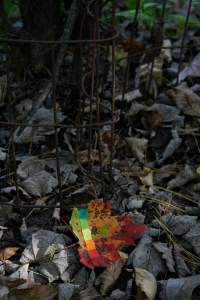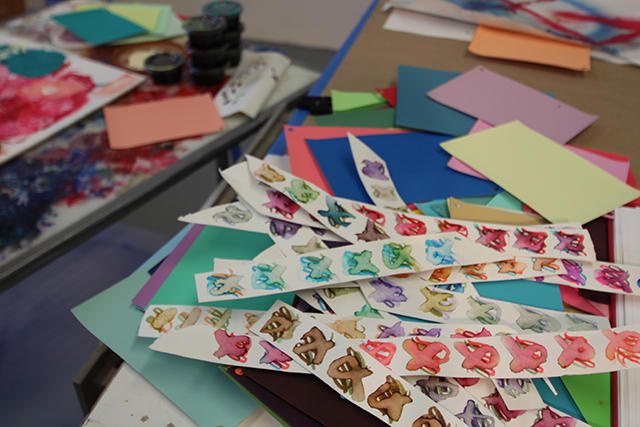
Fig. 38: in autumn, some leaves will use color bars to help get everything perfect.
Watercolor on maple leaf, archival computer print, dimensions variable, 2011
Briefly describe the work you do.
My work has always followed dual paths, one path is creating political or social commentary and the other is creating lighter, more aesthetically focussed work. Right now, I’m working on my ‘historical’ marker series and my ‘decorating nature’ series. I love having both of them to move forward with.
Tell us a little about your background and how that influences you as an artist.
My mother was an artist and my father was a businessman and inventor. They were both very creative individuals and I truly believe I inherited some of that from them.
The concept of the “artist studio” has a broad range of meanings, especially in contemporary practice. The idea of the artist toiling away alone in a room may not necessarily reflect what many artists do from day to day anymore. Describe your studio practice and how it differs from (or is the same as) traditional notions of “being in the studio.”
I still have a proper studio where my easel lives but these days, most of my work is on the computer or on the desk where the computer sits when the watercolors aren’t there. I’m happy to work anywhere but sometimes miss my time in front of the easel.

Fig. 90: it’s said that if you arrange the leaves of the bluepoint tree in a circle, you will attract true love.
Watercolor on leaves, archival computer print, dimensions variable, 2013
What unique roles do you see yourself as the artist playing that you may not have envisioned yourself in when you first started making art?
I never imagined how much education I would be involved with when I embarked on a career as an artist. I visit a lot of schools and give a lot of talks to young people, mostly high school age. It’s a surprising and delightful aspect of my job.
When do you find is the best time of day to make art? Do you have time set aside every day, every week or do you just work whenever you can?
I’m really happy to be working on art-making at any time of day. I do a fair amount of writing and creative writing and find that my mind for that is best in the morning hours. I’m up at 5 or 6 usually and will try to get as much of that done as I can before the kids get up. After that, I’ll work on whatever needs attention that day. I love painting throughout the day and after dark am happy to get back on the computer again.

Fig. 56: not normally associated with seasonal transformations, some stream-side stones actually will begin to pixellate in late autumn/early winter.
Watercolor on stone, archival computer print, dimensions variable, 2012
How has your work changed in the last five years? How is it the same?
The last 5 years have actually been a great time for me artistically. I’ve done a couple of educational apps for iOS and have just finished a major proposal for a regional children’s museum. I still work on my on-going projects but it’s always nice to have new challenges, too.
Are there people such as family, friends, writers, philosophers or even pop icons that have had an impact on the work you do?
I started out painting making copies of works I liked. I really liked Matisse’s cutouts and Hockney’s California paintings and eventually, I started to combine the two of them into canvasses that a friend dubbed “Hocktisses”. After that, I began to experiment more and more, incorporating motifs from American and Mexican folk and outsider art. I’m drawn to obsessive work and most of my early paintings show that.
If you had an occupation outside of being an artist, what would that be and why?
I really can’t imagine a non-creative career. If I had to choose just one art path to the exclusion of all others, I would choose acting. It’s incredibly satisfying physically, intellectually and emotionally. I used to work a lot in advertising and still do some of that. If I couldn’t do any art, I would choose advertising, it’s a lot of fun, too.
About
Norm Magnusson is mildly renowned all over the world.
As a visual artist, he has shown in galleries and museums in New York and New Zealand, London and Paris and all over the United States. His work is in private and museum collections around the world, including NY’s MoMA and he’s been reviewed everywhere from the NY Times to the Woodstock Times and from the Washington Post to the Utne Reader and many other national and international magazines, websites and blogs.
His “historical markers” and “decorating nature” series have both gone viral on the internet; he’s received a NYFA Fellowship for sculpture, a Pollock-Krasner Foundation grant for paintings, a Lower Manhattan Cultural Council grant and, through the CSRC, a NYSCA grant, both for public art installations. For the last 4 years, on August 29, the date of its world premier in Woodstock, NY, Magnusson has produced an anniversary concert of John Cage’s 4’33”.
Recently, he’s returned to his first creative love, acting, starring in community theater productions of plays by David Mamet and David Ives and, most recently, as Pozzo in Samuel Beckett’s “Waiting for Godot.” He wrote and performed his first ever words and images monologue “The signs in our lives” at the Hudson Literary Festival in 2014.
He is the co-founder of FISHtheMOUSEmedia, a developer of educational apps for iOS; where his “Animal alphabet” app was widely acclaimed and honored with a prestigious Gold award from the Parents’ Choice Foundation.
decoratingnature.blogspot.com/
All images copyright of the artist and used with their permission.



Wondrous stuff!